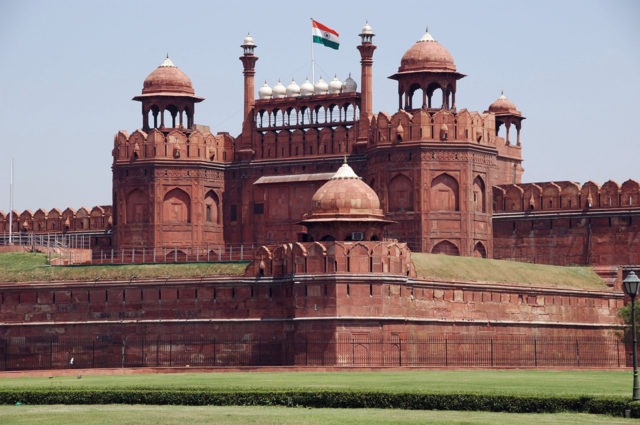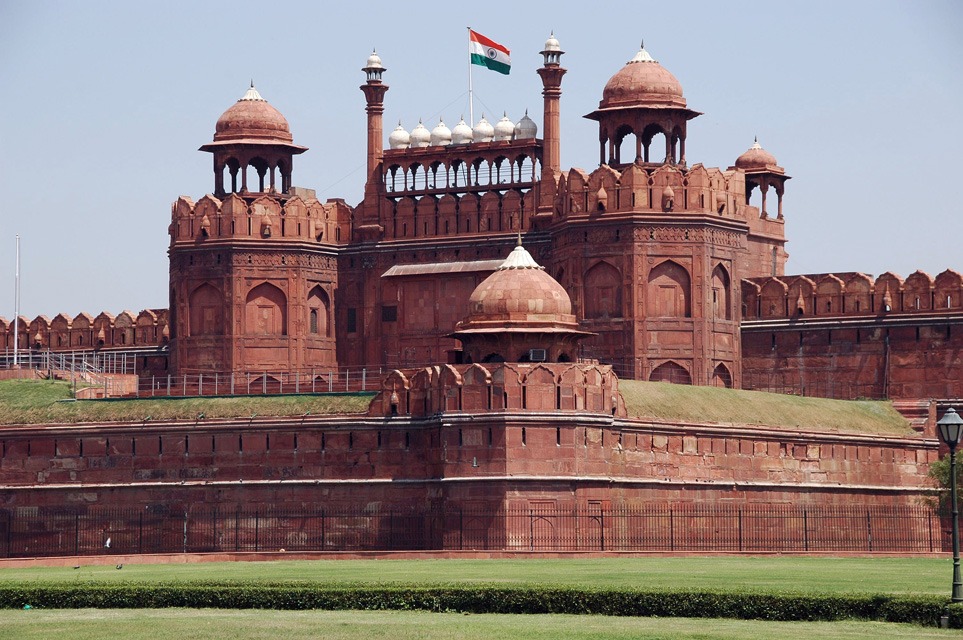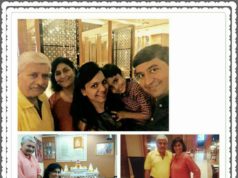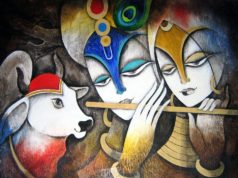Lead me from the Unreal to the Real, From Darkness to light, From Death to Immortality” Vedic verse chanted at Gandhiji’s funeral pyre
Made of Red Sandstone, Red Fort completed in 1648, once served as the Imperial Palace of Moghul Emperors. It was built by the Great Mughal Emperor Shah Jahan, seat of Bahadur Shah Zafar, the last Mughal Emperor, when he was declared Emperor of Hindustan during 1857 uprising against the British. Netaji Subhash Chandra Bose, Leader of the exiled Azad Hind Government wished to hoist the flat of Free India from the Red Fort. Pandit Jawaharlal Nehru, the First Prime Minister of India hoised the Flag on 15th August 1947 at the Red Fort. It proclaimed Free & Independent Nation. This flag replaced the British Union Jack which had flown over India for 200 years.
The two most famous buildings of the Red Fort are the Hall of Public Audience (Diwan-i-Am), where the grand mughal presided from a royal alcove which contained the Peacock Throne, and the smaller Hall of Private Audience (Diwan-i-Khas). The decorated white-marble walls of the latter, considered a masterpiece of Mughal architecture, are inscribed with a couplet in Persian that has been translated in English as: “If there is a heaven on earth, it is this—it is this.” Other features in the Red Fort are the Painted Palace (Rang Mahal) and the Pearl Mosque (Moti Masjid).
INDIA INDEPENDENCE | REPUBLIC DAY
Click for Profiles below
GANDHIJI | NEHRU | RABINDRANATH TAGORE
“Long years ago, we made tryst with the destiny and now the time comes when we shall redeem our pledge. At the stroke of midnight hour, when the world sleeps, India will awake to life and freedom” said Jawaharlal Nehru. Today, India is a Can-do Nation, Democracy intact, jubiliation in real.
India, the Land of Legends (Free), proudly stand independent and as we commemorate the nation on its Anniversary of Independence/Republic Day, Kids Free Souls salutes all those immortal souls for their gallant undying contribution for the cause of the freedom.
Keep the Faith!
– ilaxi patel
Editor Online, kidsfreesouls.com
HISTORY OF INDIA
On the night bridging to 15th August 1947, thousands of people gathered to rejoice the Independence of the nation outside the Assembly building and as dawn showed the bright glow, JawaharlalNehru, the first Prime Minister of India unfurled the national flag on the ramparts of the Red Fort. It was a moment of freedom, joy, peace and unity.
The vedic verse chanted at the funeral pyre of Gandhiji “Lead me from the Unreal to the Real, from Darkness to light, From Death to Immortality” reminds us of the sacrifice, determination, dedication and devotion of our leaders, the makers of true India.
India, a sub-continent with 5000 year old History. A civilization united by its diversity, richness of culture, the glory of past, the turbulences and triumphs. The landmarks of each era, the achievements of a change, the legacy of a regime. As we walk through the history, India is an amazing discovery and its itihaas is a unique tale of the past.
Itihaas has its roots from ancient, medieval, independent, modern advancements. The Indian Flag represents the entire country. Its people, its beliefs, its values…It represents me & you, every citizen of India. The tri color flag was developed in the 20th century, originally a spinning wheel was shown in the white band. This symbolised the Gandhian ideal of self sufficiency. In 1947, the chakra was officially adopted in place of the spinning wheel. This is an ancient Indian symbol associated with the powers and changes of nature. Officially, the orange color stands for Courage and sacrifice. The white color signifies Peace and truth. While green symbolises Faith and Chivalry. It is the duty of every Citizen to realise the significance of our flag and pay the honour and respect its commands.
The rich tradition and culture of India reflects India’s true blends of rich flavours of harmony. The ancient India which covers Pre-historic age, vedic, epic, Indus valley, Maurya and gupta dynasty, tugluq raids, etc. The Independent India is a struggle for freedom. The British raj, Indian National congress, Gandhian era, Quit India and the Modern India, the largest democratic country in the world. India has Industrial powers, a breakthrough in all major fields, fastest developed economy and the 7th Largest country in the world.
INDIA derived its name from the river Indus, which the early Aryans called the ‘Sindhu’ (ocean) meaning a huge sheet of water. This great river in the ancient time formed the western boundary of India. The Persians, who conquered the country around the river Sindhu, pronounced the letter ‘S’ as ‘H’, thus, terming the region beyond the Sindhu as ‘Hindu’ or ‘Hind’. With the coming of the muslims, the name became Hindustan and the people inhabiting the land were known as Hindus, Europeans, however, called India the country of the Indus.
The National Emblem
The National Emblem is an adaptation of Ashoka’s pillar, Sarnath. The emblem shows only three of the four lions which are visible on the Ashokan pillar. The wheel portrayed in the centre of the abacus has a bull to the right and horse to the left. The pillar, however, also has an Elephant and a Rhinoceros at the back. The words ‘Satyameva Jayate’ means ‘Truth alone triumphs’ are inscribed below the abacus in the Devnagari script. The emblem is used on all official stationery and seals of the Government of India. It also appears on Govt. publications and films, coins, currency notes etc.
Pandit Jawaharlal Nehru addressed the nation on Gandhiji’s Assasination
‘The Light has gone out of our lives and there is darkness everywhere. Our beloved leader, Bapu, as we called him, the Father of the Nation is no more.. And yet I am wrong for the light that shone in this country was no ordinary light. A thousand years later, that light will still be seen.
REPUBLIC DAY – 26TH JANUARY
The first Republic Day Parade was held at Irwin Stadium (the present National Stadium in Delhi, India). The hoisting of the national flag by the President and a parade of units representing all the armed forces are the highlights of the ceremonies. Since many years, the Republic Day Parade starts from Rashtrapati Bhavan and winding its way through the heart of the city, ends at the historic Red Fort in Old Delhi.The celebrations are spectacular with ‘Beating Retreat’ three days later on 29th January. The notes of ‘Abide with me’,favourite of Mahatma Gandhi is played with final retreat marking the end of Republic day celebrations.
The rich tradition and culture of India reflects India’s true blends of rich flavours of harmony. The Independent India is a struggle for freedom. India became a Republic and the constitution came into force on January 26, 1950. The Constituent Assembly was convened and appointed a committee with Dr. B.R.Ambedkar as Chairman to draft the Constitution. India declared herself to be a Sovereign Democratic Republic. The Indian Constitution, the longest in the world, consist 397 articles and 12 schedules, which provides for a single citizenship for the whole of India. It gives the right to vote to all citizens of 18 years and above, unless they are disqualified. Fundamental rights are guaranteed to the citizens, equality of religion and so on. The Supreme Court, consisting of the Chief Justice of India and other judges, is the guardian of the Constitution. It stands at the apex of a single integrated judicial system for the whole country. This is where the fundamental rights of the citizens are protected.
The Political Model – The constitution pledge to solemnly resolve to constitute India into a Sovereign Socialist Secular Democratic Republic and secure to all citizens its rights:
The Political Model – The Constituion
The constitution :
We, the people of India, having solemnly resolved to constitute India into a Sovereign Socialist Secular Democratic Republic and to secure to all its citizens:
*Justice, social, economic and political
*Liberty of thought, expression, belief, faith and worship
*Equality of status and of opportunity and to promote among them all
*Fraternity assuring the dignity of the individual and the unity and integrity of the nation
In our Constituent Assembly this twenty sixth day of November 1949, Do Hereby Adopt, Enact and give to ourselves this Constitution.
The constitution of India was originally written in English. A hindi translation was issued on January 24, 1950.
Happy Republic Day. Dr. B R Ambedkar as Chairman drafted the Constitution which came in force on January 26, 1950. This day, India became a Sovereign Democratic Republic. Main features of Indian Constituion: |
REPUBLICAN DAY MESSAGES THEN…..
Dr. Rajendra Prasad in his special message to his countrymen, on the birth of the Indian Republic
“We must re-dedicate ourselves on this day to the peaceful but sure realisation of the dream that had inspired the Father of our Nation and the other captains and soldiers of our freedom struggle, the dream of establishing a classless, co-operative, free and happy society in “his country,”
“We must remember that this is more a day of dedications than of rejoicing – dedication to the glorious task of making the peasants and workers the toilers and the thinkers fully free,happy and cultured,” he added.
C.Rajgopalchari’s message
“On the eve of my laying down office, with the inauguration of the Republic, I should like to tender my greetings and best wishes to the men and women of India who will henceforth be a citizen of a republic,” said His Excellency the Governor-General, in a broadcast talk from the Delhi Station of All-India Radio on Wednesday night.
“I feel deeply thankful for the affection showered on me by all sections of the people, which alone enabled me to hear the burden of an office to the duties and conventions of which I had been an utter stranger.
Did you Know?
The Republic day celebrations are spectacular with ‘Beating Retreat’ at Vijay Chowk in New Delhi three days later on 29th January. The notes of ‘Abide with me’, favourite of Mahatma Gandhi is played by mass bands of armed forces with final retreat marking the end of Republic day celebrations.
You can listen to the most popular Hymn ‘Abide with me’. The song is written by Henry Lyte, a vicar who lived in the fishing village of Brixham Devon . He was dying of Tuberclosis and as he walked by the sea and heard the ebb and the flow of the tide and for the last time there, he watched the sun, he wrote the touching song.
Where is death’s sting? Where, grave, thy victory?..The quote from St. Paul, Bible, the Hymn if often sung at funerals. Even after the first world war, it became traditional to sing this Hymn after the Football Cup Final at Wembley In London, first suggested by King George (fifth)
Abide with me; fast falls the eventide;
The darkness deepens; Lord with me abide.
When other helpers fail and comforts flee,
Help of the helpless, O abide with me.
Swift to its close ebbs out life’s little day;
Earth’s joys grow dim; its glories pass away;
Change and decay in all around I see;
O Thou who changest not, abide with me.
Not a brief glance I beg, a passing word,
But as Thou dwell’st with Thy disciples, Lord,
Familiar, condescending, patient, free.
Come not to sojourn, but abide with me.
Come not in terrors, as the King of kings,
But kind and good, with healing in Thy wings;
Tears for all woes, a heart for every plea.
Come, Friend of sinners, thus abide with me.
Thou on my head in early youth did’st smile,
And though rebellious and perverse meanwhile,
Thou hast not left me, oft as I left Thee.
On to the close, O Lord, abide with me.
I need Thy presence every passing hour.
What but Thy grace can foil the tempter’s power?
Who, like Thyself, my guide and stay can be?
Through cloud and sunshine, Lord, abide with me.
I fear no foe, with Thee at hand to bless;
Ills have no weight, and tears no bitterness.
Where is death’s sting? Where, grave, thy victory?
I triumph still, if Thou abide with me.
Hold Thou Thy cross before my closing eyes;
Shine through the gloom and point me to the skies.
Heaven’s morning breaks, and earth’s vain shadows flee;
In life, in death, O Lord, abide with me
{jathumbnail off}









